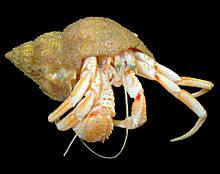Decapods
| Decapods | ||||||||||||
|---|---|---|---|---|---|---|---|---|---|---|---|---|

|
||||||||||||
| Systematics | ||||||||||||
|
||||||||||||
| Scientific name | ||||||||||||
| Decapoda | ||||||||||||
| Latreille , 1802 |
The decapods (Decapoda) form an order within the class of the higher crabs . Approximately 15,000 species of crustaceans belong to the decapod crabs , including the most famous groups such as the large crabs , which include the crayfish and lobsters , the hermit crabs , the crabs , the lobsters and most of the shrimp . The decapods are the most species-rich group of crustaceans .
features
Decapod crabs are between one millimeter (a type of partner shrimp ) and 60 centimeters long (the lobster Jasus huegeli ) and, with the Japanese giant crab, are also the crustacean with the largest span of the limbs (3.7 m). They have spawned an abundance of body shapes. However, a division into cephalothorax and pleon can always be seen. The shrimp, lobster and crayfish, like the lobster, have an elongated body, often slightly flattened on the sides, the cephalothorax of which ends in an often sawn rostrum . Their antennas are long, thin and sturdy. The first two to three striding legs carry scissors. The abdomen is clearly structured, provided with swimming legs and ends in a tail fan, with the help of which they can quickly flee backwards in case of danger. In contrast, the body of the crabs is rather broad than long. A rostrum and a tail fan are missing, so that the animals cannot swim backwards either. The antennae are short, the abdomen is short, narrow and is carried folded forward under the cephalothorax. Since the swimming legs have receded, or the females only use them to carry the eggs around, most crabs cannot swim. However, the swimming crabs have regained their swimming ability by converting their hind legs into paddle-like organs. A third body type is represented by the hermit crabs , which are asymmetrical to hide in snail shells. Their abdomen is soft and swollen because it contains some of the organs that are found in the cephalothorax of other decapods.
distribution
Decapods are mainly marine animals and at home in all of the world's oceans, although they are poor in species in the polar ones. They are particularly species-rich on the coasts, from the shelf to the intertidal zone. They live mainly on the sea floor, pelagic species living in open water are rare. Various groups have migrated to fresh waters or switched to rural life (e.g. the palm thief ). However, all decapods have to get back in and out of the water in order to reproduce. Finds of fossil crabs of this order are common in the Engelbostel brick mine .
Systematics
Within the Decapoda, a distinction is made between two monophyletic sub-orders, the Dendrobranchiata and the Pleocyemata . A more detailed description of the system can be found in the system of decapods .
- Order decapods (Decapoda)
- Suborder Dendrobranchiata
- Subordination pleocyemata
- Infraorder Achelata
- Infraorder medium crayfish (Anomura)
- Infraorder large crayfish (Astacidea)
- Infraorder Axiidea
- Infraorder Crabs (Brachyura)
- Infraorder Caridea
- Infraorder Gebiidea
- Infraorder Glypheidea
- Infraorder Polychelida
- Infraorder stenopodidea
use
Decapods are considered a delicacy and an important fishery product. Shrimp species living in the cold water of the deep sea are mainly fished, while species living in warm water are bred in aquacultures in India, Southeast Asia, the USA and South America . Above all, the meat of the abdomen, which only contains muscles and no organs, is eaten, as is the meat of the claws in the case of lobsters and crabs.
literature
- Wilfried Westheide , Reinhard Rieger: Special Zoology. Part 1: Protozoa and invertebrates. 1st edition. Gustav Fischer Verlag, Stuttgart / Jena / New York 1996, ISBN 3-437-20515-3 , pp. 561-567.
- Sammy De Grave, N. Dean Pentcheff, Shane T. Ahyong, and others. a .: A classification of living and fossil genera of decapod crustaceans . In: Raffles Bulletin of Zoology . Supplement No. 21. 2009, p. 1–109 ( pdf 7.73Mb [accessed March 11, 2012]).
Individual evidence
- ↑ Joel W. Martin, Keith A. Crandall, and Darryl L. Felder (Eds.): Decapod Crustacean Phylogenetics . Taylor & Francis Group, 2009, Preface, p. IX.
- ↑ Detlef Müller: The brick stone pit of Engelbostel near Hanover. In: primeval and early times. Issue 1/90, Hagerberg Hornburg 1990, ISSN 0170-5725 , p. 33.
Web links
- Assembling the Tree of Life: AToL Decapoda
- Integrated Taxonomic Information System Decapoda Latreille, 1802



